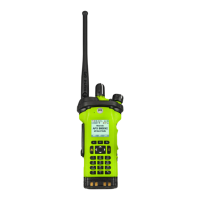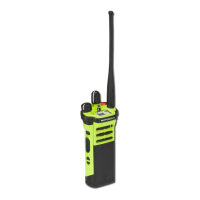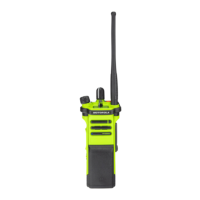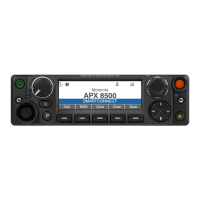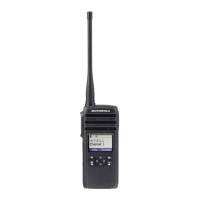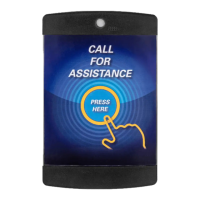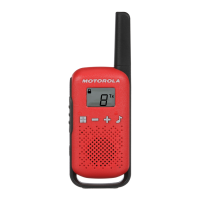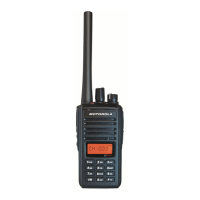
Do you have a question about the Motorola solutions APX N70 and is the answer not in the manual?
| Frequency Bands | VHF, UHF, 700/800 MHz |
|---|---|
| Channels | 3000 |
| GPS | Yes |
| IP Rating | IP68 |
| Operating Temperature | -30°C to +60°C |
| Display Size | 2.4 inches |
| Battery | Li-Ion |
| Display | Color |
| Bluetooth | Bluetooth 4.0 |
| Wi-Fi | 802.11 b/g/n |
| Encryption | AES-256 |
| Frequency Range | 136-174 MHz, 380-520 MHz, 764-870 MHz |
| Encryption Type | AES-256, DES |
Covers copyrights, trademarks, license rights, and open source content for the radio manual.
Provides crucial safety guidelines and warnings related to radio usage and RF exposure.
Outlines the scope and duration of the Motorola Solutions limited warranty for communication products.
Details the terms, conditions, and exclusive remedies under the limited warranty.
Provides instructions on obtaining warranty service, including proof of purchase and contact information.
Lists items and conditions explicitly excluded from the limited warranty coverage.
Explains standard notations like Warning, Caution, and Note used in the publication for clarity.
Describes how to interact with the radio's touchscreen using gestures like tap, swipe, and pinch.
Provides instructions and cautions for cleaning the radio's exterior surfaces and contacts.
Explains the importance of proper maintenance and where to obtain service for the radio.
Details how system administrators can assign functions to programmable buttons and switches.
Introduces ViQi, a virtual assistant for managing the radio using voice commands.
Step-by-step guide for attaching and removing the radio's battery pack.
Instructions for securely attaching and removing the radio's antenna.
Provides instructions and warnings for safely charging the radio using approved chargers.
Explains the functionality and usage of the radio's on-screen keyboard for text input.
Describes the widget displaying radio identity and operational status, allowing status updates.
Details how to log in and out of services like Automatic Registration Service using a username.
Guides users through logging into the CommandCentral system for advanced features.
Explains various icons and LED indications that display the radio's status and notifications.
How to view, respond to, and clear notifications received on the radio.
Explains how to lock and unlock the radio's controls to prevent accidental changes.
How to access and view essential radio information like software version and device status.
Methods for navigating and selecting different zones on the radio.
Procedures for choosing specific channels within a selected zone.
Guide to adding frequently used channels to dynamic zones for quick access.
How to initiate different types of calls, including talkgroup, private, and selective calls.
How the radio handles incoming calls like talkgroup, call alert, private, and selective calls.
Scenarios and outcomes when using the emergency button or mode.
How to transmit an emergency alarm to the dispatcher and what indications to expect.
Steps to cancel emergency modes initiated by the radio or supervisor.
Guide to setting up and entering the Fireground zone channel for incident operations.
Details TPS emergency transmission, including beacon and de-key sidetone alerts.
Explains the audio and display alerts when the Man Down feature is activated.
Procedure for testing the Man Down (Fall Alert) functionality to ensure it works.
How to switch between secure encrypted and clear unencrypted transmission modes.
How to request remote reprogramming of encryption keys via Over-the-Air Rekey (OTAR).
Procedures for enabling and disabling the radio's scan functionality.
Steps to re-add nuisance channels back to the scan list after temporary removal.
How to create, assign priorities, and manage channels within scan lists.
Using CPS software via USB for radio programming in offline situations.
Information on LTE connectivity for features like SmartProgramming and SmartConnect.
How the radio switches to Wi-Fi or LTE when LMR is out of range for continuous communication.
How to connect external Bluetooth accessories to extend radio functionality.
Procedure for transferring files to the radio using a USB cable.
How to enable or disable the radio's location services.
Information on saving and managing waypoints, including automatic saving during emergencies.
Feature to view own location and other units' locations on a map or list view.
Describes radio behavior upon entering a predefined geographical Geofence area.
Explains how the radio reverts to normal operation after exiting a geofence area.
Introduces the radio's address-book capabilities and entry information.
Procedures for viewing, adding, editing, and deleting contacts and call lists.
How to access and filter recent incoming and outgoing call history.
Displays current user status (Available, Unavailable, etc.) in various screens.
Procedure for composing and sending predefined text messages to individuals or groups.
How to view, play, and forward image, video, audio, or location attachments.
Step-by-step guide to composing and sending new text messages from the radio.
How the radio functions during a trunked system failure using failsoft mode.
How the site reverts to site trunking when losing communication with the Zone Controller.
How radios are classified into Select Enabled or Select Disabled categories for regrouping.

